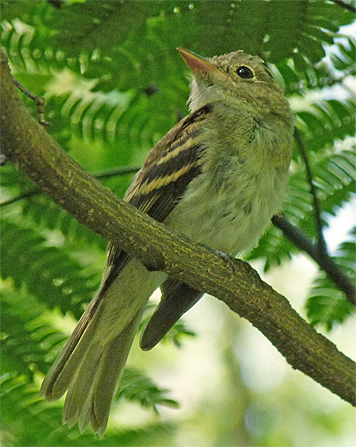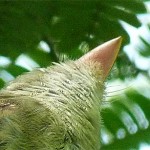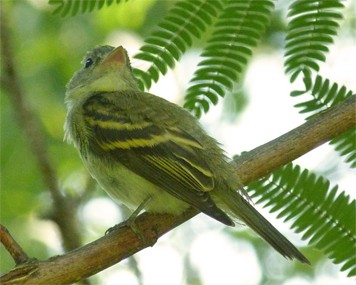
I’ve seen flycatchers here at the Museum before but except for the Eastern Phoebes and Great-crested Flycatchers that nest here every year, they were passing migrants. What I saw last Saturday was a group of what I think were two or three empidonax flycatchers.
“Whoa, what’s an empidonax flycatcher?”
Empidonax flycatchers (empids) are a group of rather small birds with brown-green plumage, light colored eye rings, and whitish wing bars that are often difficult to tell apart except by voice and or habitat. But they don’t often vocalize outside of the breeding season and they’re not always in the same habitat that they breed in, especially during migration.
When I saw the birds on Saturday in Catch the Wind I didn’t know what they were but I could tell from their behavior that they were flycatchers. Flycatchers typically sit on a perch, scan the immediate area for insects, and fly out to snatch them (if you’re close enough to them you can sometimes hear the “snap” of their bills as they catch an insect). These birds looked like empids, but they could also be Eastern Wood Pewees.
I came across the family group again on Thursday while they foraged near the Secondary Wetlands Overlook in Explore the Wild. This time the birds were closer to eye level, I had my binoculars handy, a camera strapped to my side, and the trusty ‘ol iPhone ready to record their calls. I could see them clearly in the binoculars, got a bunch of photos with the camera, and was able to get usable audio of the birds with the iPhone to compare with known calls of juvenile birds, if I could find any on the internet.

You can tell the various empids from one another by certain measurements of the wings, tail, bill length and width, and even the color of the underside of the bill, but I wasn’t holding the birds in my hand and I don’t want to bore you with all of the minutiae of empid identification. I’d have to relearn it myself and I simply don’t want to do that right here and right now. And besides, there’s only one empid likely to be seen in these parts at this time of year, an Acadian Flycatcher. So they were either Acadians or pewees.
Still reading?
Acadian Flycatchers are common in our area. A walk along any river course here in the Piedmont and you can hear Acadian after Acadian as you walk along the river’s banks going from one bird’s territory to another. The song, if that’s what you want to call it, is often described as “peet-su” or “pizza” uttered with fair emphatitude.
Eastern Wood Pewees are common here too. I’ve heard one off and on here on campus throughout this summer. The “Pee-a-wee” call of this small flycatcher is distinctive.
Pewees and empids differ in one way that can be easily discerned, empids have eye rings (a contrasting ring of tiny feathers around the eye) and pewees don’t. But sometimes juveniles can be a bit confusing, especially if you’re rusty at bird ID.
Well, the birds that I was now looking at, and that I was very close to, were calling as they flitted around the mimosas, grape vines, and maples along the north side of the Wetlands. It sounded like the call of an Acadian Flycatcher, but it was cut off, only half of the call was coming out of the birds’ mouths, the “peet” part of the call. But these were juveniles and they weren’t singing to find a mate or to establish a territory, they were calling out to either locate one another or to keep in touch with Mom or Pop.
Over the years, I’ve forgotten more than I now know about bird identification so I took my photos and call notes, via the camera and iPhone, to Nathan Swick, one of our Summer Camp Educators. I was looking for a little support or reinforcement and Nathan is a birder who actually practices the art of birding. After a little back and forth it was decided (note: it can be difficult to ID birds from photos due to the static poses of the subject, color differences caused by the lighting, and angles) we both thought the birds were Acadian Flycatchers.
Previously, I’d seen perhaps one or two Acadians here at the Museum. One of those Acadians was seen in June a few years back. It was in the woods out behind the Dinosaur Trail. I thought it odd at the time because it was so late in the season, migration of these bird was well past and any birds that were in the area should be residents, nesting birds. Since I most often see the birds along moving water I didn’t expect them here. Although Ellerbe Creek runs through the property, the lone bird that I saw in June was not very close to that stream. Looking back, Acadians have probably been nesting here all along and I’ve simply not seen or heard them.

By the way, I did find a web site that had the calls of both fledgling Eastern Wood Pewees and Acadian Flycatchers. The call that I recorded most closley matched: “Calls by three newly fledged Acadian Flycatchers which were perched together up in a tree (Aug, PA),” which you’ll see when you scroll just a little short of halfway down the page.
What does the sighting of this family group of Acadian Flycatchers mean in the grand scheme? Not much, but I was still a bit excited to see and hear the birds here at the Museum where they hadn’t been recorded nesting before, at least by me. It was a nice surprise.